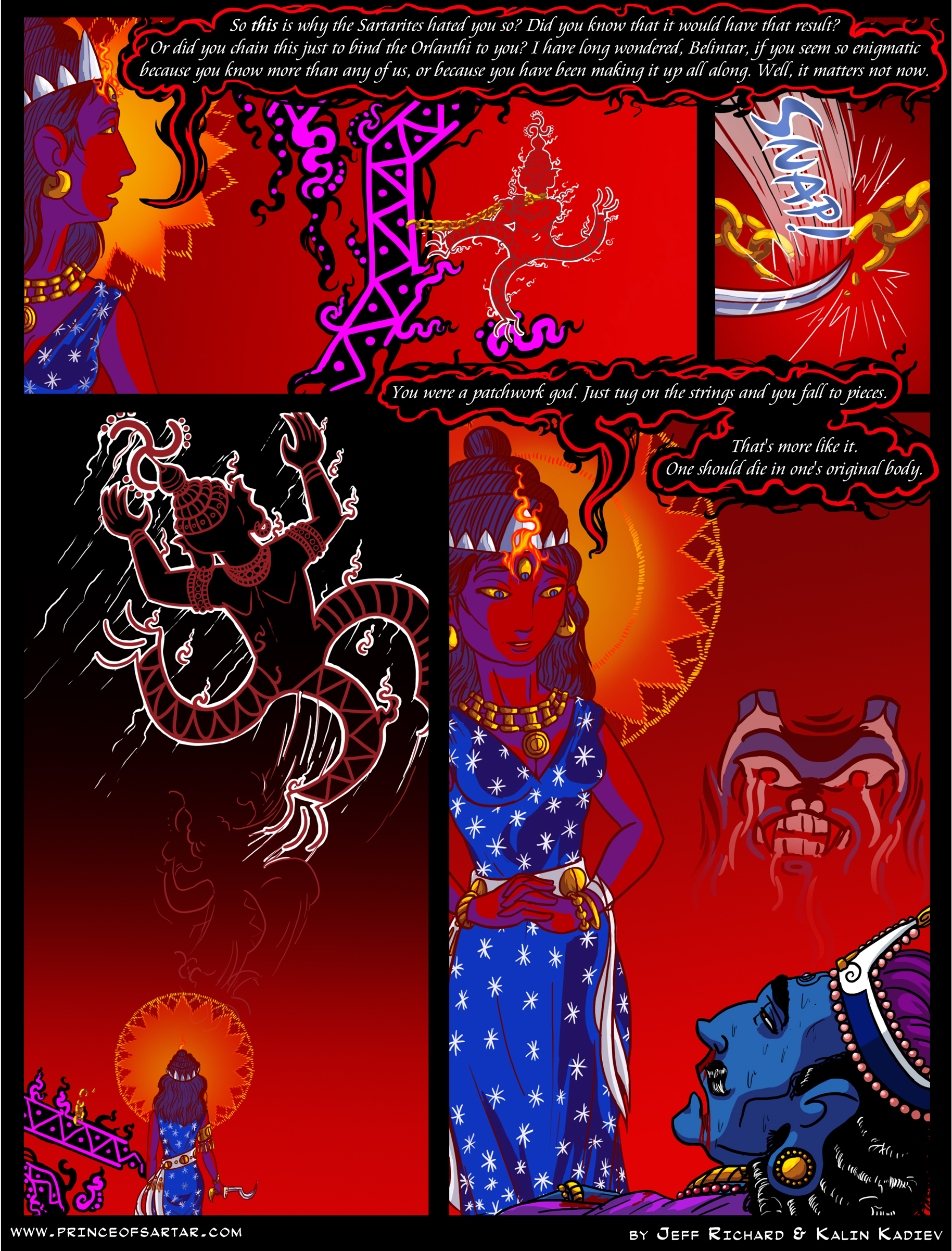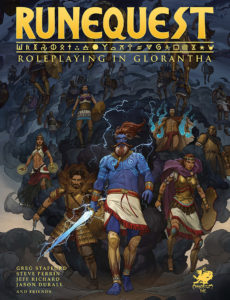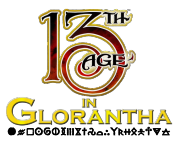Prince of Sartar
How one man became a god
There are currently no widgets assigned to the left-sidebar, place some!
Once you add widgets to this sidebar, this default information will go away.
Widgets can be added by going to your dashboard (wp-admin) ➔ Appearance ➔ Widgets, drag a widget you want to see into one of the appropriate sidebars.
Once you add widgets to this sidebar, this default information will go away.
Widgets can be added by going to your dashboard (wp-admin) ➔ Appearance ➔ Widgets, drag a widget you want to see into one of the appropriate sidebars.
Languages
Prince of Sartar is an epic story of the Hero Wars set in Greg Stafford's Glorantha.
By Jeff Richard and Kalin Kadiev.
Curious about Glorantha?
Chapters
Recent Comments
- jaguar on 119 – Time to rest
- Colie Dillon on 119 – Time to rest
- Steve S. on 119 – Time to rest
- Oliver Dickinson on 119 – Time to rest
- greattsathoggua on 119 – Time to rest






Strange to see the White Bear and an Avatar of the Red Goddess on the same side of anything.
This sort of looks like there is a Lunar chef filleting a bear’s feast. Too bad that Harrek is after bone and gristle, too…
I think she’s going to feed Belintar to the bear god!
So what is that spirit with the Motion rune that was chained to Belintar’s god-form?
It’s the Spirit of Freedom.
And finally, it’s free.
More consequences from Jar-Eel’s intervention to haunt the Lunars later.
So why did she do it? Did she not think her actions through? Or does her love of freedom and/or fair play outweigh her concern for tactical advantage?
I suspect that they just did not realize the consequences. After all, from the Lunars’ point of view in 1616, they are in successful expansion mode.
Tarsh is largely integrated, and the Pelorian nomads quiet. Sartar is subjugated, and Prax captured. And if they can get rid of the Pharaoh, the richest prize of them all, the Holy Country, is there for the taking. The fabulously fertile fields of Esrolia. Nochet the largest city in the world. Access to the newly opened sea and all its wonders.
Meanwhile, they have a true Inspiration of Moonson – only the 4th in the history of the Empire, available to lead the assault, and a distracted oponent.
Is there ever going to be a better moment?
And if you are going to dismember the Pharaoh, best to do a proper job of it, and cut up all the pieces, to ensure that he does not come back.
Or perhaps she knew the that the final reckoning is to come? Motion and change is part of the Lunar Way even if crypto-Yelmic Imperialists seek to imprison Her in a cage of Static Mastery!
Congratulations Kalin for the drawing of Jar-Eel in the first panel. Simply beautiful. It’s a good balance between realist depiction and “clear line” comics 🙂
Is the original body blue? Or is that comic coloring?
Belintar does look like he was originally blue. Such a tantalizing hint on his origins, but also not a very helpful one: there are so many races with blue skin, and he could still be from several of them. Renegade survivor Artmali? Waertagi sailor (he did swim up out of the sea)? Brithini Zzabur (unlikely)? Still quite a lot of choices.
I just checked The Guide to Glorantha Vol. I and on p.239 is describes the ascension of Belintar. There hs is described as having “bronze” skin, so either this manifestation of him is a blue skinned individual or his colour is something else, as that description in the Guide do not match the pages of the “Prince of Sartar” comic.
That image is explicitely “Belintar’s Ascension”, after a number of changes Belintar underwent during his struggle for domination of Kethaela – killed several times, eaten once…
I think that Jar-eel returned Belintar to the body in which he swam ashore, rather than the body that he underwent his ascension.
This feels much like an inconsistency error to me, but sure we can try to make up a reason for it. Why would this be Belintar returned to his original body?
It is not an inconsistency error. Belintar upon his apotheosis in 1318 is typically described as having bronze skin. But the guy who appeared on the shores had blueish skin.
It is the considered opinion of some Lhankor Mhy sages that Belintar spent his formative years in a remnant Artmali colony in the vicinity of the one-time God Learner settlement of Feroda, in the Zola Fel delta.
This would make him one of the celebrated Delta Bluemen, famed in song and story.
I love how the elemental spirits are made up of tetrahedron symbols. Is the dotted law rune the rune for space? Or are those atoms and may we infer that the elements in Glorantha aren’t undivisible?
Hrm, I can’t help but feel that Jar-Eel’s mention of Sartarites is a mistake. Of course, it could easily be her mis-understanding of the difference between Heortlanders and Sartarites – largely they are the same people though there are many additional Alakoring and other northern Orlanthi influences on Sartarites.
The reason for my feeling is that I can’t see how Belintar’s binding of Change could extend into Sartar. It certainly did extend into Heortland and many of the first wave of Heortlanders left because of Belintar, likely due to the way he killed their king and bound the kingship (which is a good candidate for the binding of Change).
*History of the Heortling peoples* (P86) _”In 1317, Belintar killed Andrin, king of the Hendrikings, and placed guardians to prevent the Hendrikings from selecting a new high king. Though the tribes, clans and cities fought for power, Belintar resurrected Andrin (bereft of his Orlanthi breath) and appointed him Governor of the Sixth of Heortland.”_
In 1470 (P87) _”Sartar was an heir to the Hendriking “old ways.” He went to Dragon Pass for this purpose, with a long-term plan to go to the homeland (or for his descendents to do so) and rescue them from the oppression of Belintar.”_
Once there, Sartar seems to have manifested as a full Larnsting, which, in my opinion, would not be possible if Change was bound there.
eek, the second quote is from P94, not P87.
It is quite clear that Sartar bypassed the restriction by leaving Heortland. I think that the Heortlings had fallen into a similar conceptual error as us old-time grognards when we equated the term Heortland with the Volsaxi and Hendriki tribal lands (that were affected by Belintar’s magic). The rule that Larnstings were bound to Heortland and Belintar’s control over the spirit of freedom in the Hendriki lands gave the impression that no Larnstings could act while Belintar was in power. Simply going beyond the Crossline negated Belintar’s influence – after all he made a magically binding contract with the then King of Dragon Pass Ironhoof. The lands settled by the Quivini had been under Hendriki control between the massacre of the draconic leaders in 1042 and the Dragonkill of 1120. Thus, Sartar could act in Hendriki lands outside of Belintar’s control, and find a balance between freedom and enough organisation to shape squabbling tribes into a kingdom/principality.
Charles. I believe that the reference to Sartarites is correct. They would have known what Belintar had done, and hated him for it, even if they were not as directly affected as those in Heortland.
I think that’s because Sartar’s plan was to bypass Belintar’s authority. His plan was to become greater than Belintar – he became King of Dragon Pass. Larnstings are, from my understanding, not kings by a kind of mystic, who come in times of great need. Belintar stole the old kingship, so, in his fashion, Sartar embodied change, and made a new one, defeating the false unity of Nysalorism and Lunar teaching which Belintar made use of. Orlanth’s power has always been to make new things, yet still be of the ancient and eternal law.
Several of the founding kings of the Hendriki were Larnstings, but when the Hendriki kingdom had ossified, the Larnstings retreated from participating in those politics.
There were definitely more Larnstings than Larnsting kings.
I am not sure that Sartar ever compared himself to Belintar, and I don’t see Sartar’s activities as a contest of phallic dimensions with Belintar.
Sartar chose a quite different route than the Godking. Rather than remaining an immanent demigod, Sartar carved out his own place on the Gods Plane, leaving only the Flame of Sartar and his dynasty as physical remains.
A King of Dragon Pass could negotiate with Belintar on eye level – Ironhoof did. I don’t think Arim did, and I doubt that Belintar and Sartar ever had a get-together after 1495, even though they most likely exchanged diplomats. Which in a bronze or iron age society was another term for hostages. (That may be how Eonistaran’s second son ended up in Karse, a generation or two later.)
If Belintar ever displayed any Lunar powers, I strongly doubt that he used any Red Moon powers, and his illumination more likely would have Arkati roots than Pelorian ones other than Hepherones.
What is the Spirit of freedom holding? What rune is it? Is it the Sartar or the GS rune?